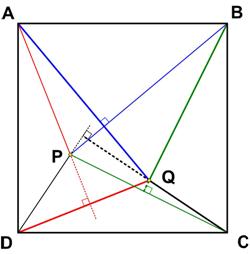 I found this problem from the Math Challenges section of the 2002 Pi in the Sky Canadian math magazine for high school students to be truly astonishing.
I found this problem from the Math Challenges section of the 2002 Pi in the Sky Canadian math magazine for high school students to be truly astonishing.
“Problem 4. Inside of the square ABCD, take any point P. Prove that the perpendiculars from A on BP, from B on CP, from C on DP, and from D on AP are concurrent (i.e. they meet at one point).”
How could such a complicated arrangement produce such an amazing result? I didn’t know where to begin to try to prove it. My wandering path to discovery produced one of my most satisfying “aha!” moments.
See the Mysterious Doppelgänger Problem
Update (12/27/2019) I goofed. I had plotted the original figure incorrectly. (No figure was given in the Pi in the Sky statement of the problem.) Fortunately, the original solution idea still worked.
 Here is another UKMT Senior Challenge problem from 2017, which has a straight-forward solution:
Here is another UKMT Senior Challenge problem from 2017, which has a straight-forward solution:

 This is a problem from a while back (2015) at Futility Closet.
This is a problem from a while back (2015) at Futility Closet. I have been subverted again by a recent post by Ben Orlin, “
I have been subverted again by a recent post by Ben Orlin, “ This is truly an amazing result from Five Hundred Mathematical Challenges.
This is truly an amazing result from Five Hundred Mathematical Challenges. Here is another simple problem from Futility Closet.
Here is another simple problem from Futility Closet.
 This is another problem from the Math Challenges section of the 2000 Pi in the Sky Canadian math magazine for high school students.
This is another problem from the Math Challenges section of the 2000 Pi in the Sky Canadian math magazine for high school students. I found this problem from the Math Challenges section of the 2002 Pi in the Sky Canadian math magazine for high school students to be truly astonishing.
I found this problem from the Math Challenges section of the 2002 Pi in the Sky Canadian math magazine for high school students to be truly astonishing. Here is yet another surprising result from Colin Hughes at Maths Challenge.
Here is yet another surprising result from Colin Hughes at Maths Challenge.